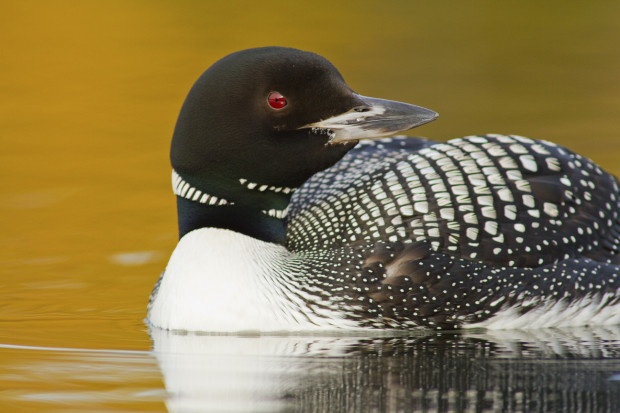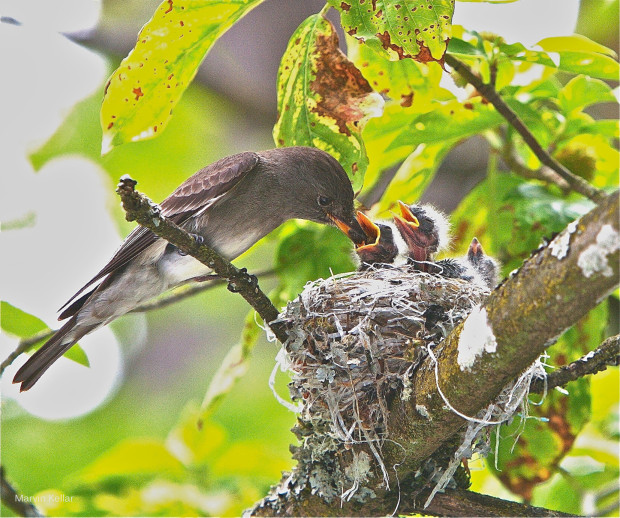We have much more to do and your continued support is needed now more than ever.
Five Things to Know about the Tar Sands Threat to American Birds
Tar sands—a mixture of sand, clay and water from which a dense and extremely viscous form of petroleum, called bitumen, can be extracted—underlie more than 54,000 square miles of northeastern Alberta, Canada. Roughly the size of Florida, this area marks the heart of North America’s bird nursery, a rich boreal region of forests, peat bogs, grasslands, lakes, rivers, swamps, marshes and shallow ponds that offer valuable and often irreplaceable nesting habitat to at least 130 species of internationally protected migratory birds and waterfowl, including the critically endangered whooping crane, the common loon and the trumpeter swan. Extracting oil from tar sands is a growing business for the oil industry and a growing threat for birds. Here are five things you should know about it.

One: The Destructive Extraction Process
The oil industry extracts oil from tar sands within 250 feet of the surface through strip mining, tearing away the soil after clear-cutting forests and removing other vegetation. Drilling and the injection of high-pressure steam are used to reach deeper layers.
The extraction process is energy and water intensive. By 2007, Alberta’s tar sands operations were permitted to remove enough water from nearby rivers to meet the needs of a city of 3 million people. Water removal is projected to increase by at least 50 percent as additional projects become operational.
Most of the water comes from the Athabasca River—as much as 15 percent of the river’s weekly flow can be taken legally—causing concerns that low-flow periods will increase mortality of fish and other aquatic organisms that are a source of food for birds. As mining operations change regional wetlands, rivers and underground reservoirs, they threaten hundreds of thousands of birds dependent on these wetlands and waterways.

Two: Threats to Bird Habitat
Tar sands operations destroy wildlife habitat by mining and by the creation of vast tailings ponds, as well as through fragmentation of mature forests by infrastructure for oil exploration, drilling, transport and processing. Some facts:
- At least 89 tar sands drilling projects and six mines punctuate northeastern Alberta.
- Strip mining of more than 1 million acres in Alberta’s boreal forests has resulted in the loss of breeding habitat for millions of birds.
- Studies have found no evidence that strip-mined areas can be restored.
Three: Threats to Birds
The boreal forest of northeastern Alberta is an important breeding area for nearly 300 bird species, at least 130 of which use the tar sands area. One square mile of forest in northeastern Alberta can support as many as 500 breeding pairs of migratory birds, some of the highest densities anywhere in Canada’s boreal forest. As many as 170 million birds breed yearly in the tar sands area. A recent study estimated that tar sands operations have caused the loss of as many as 402,000 birds. Some facts:
- Water and solids removed during tar sands processing are sent to vast tailings ponds that are some of the largest human-made structures on Earth, covering more than 65 square miles—an area about the size of Washington, D.C.
- Mistaking tailings ponds for natural ponds, waterfowl and shorebirds land in them and become oiled with waste bitumen and toxic elements. Up to 90 percent of oiled birds drown or die from hypothermia when their oiled feathers lose the ability to insulate. Birds also can absorb tar sands toxins through inhalation, ingestion and skin contact.
- At least nine bird species found in the tar sands region have lost more than half their population during the past 50 years, including the horned grebe, lesser yellowleg, short-billed dowitcher, boreal chickadee, olive-sided flycatcher, evening grosbeak, lesser scaup, greater scaup and northern pintail.
- The lesser scaup, the population of which has declined as much as 70 percent in the past 30 years, is a widely reported casualty of tailings ponds.

Four: Tar Sands and Climate Change
Tar sands oil production emits three times more global warming pollution per barrel than does conventional oil due to the large amounts of energy needed for processing. Carbon pollution from Canadian oil sands are expected to reach 108 megatonnes by 2020—a fifth of Canada’s current national emissions.
Temperatures in Canada’s boreal forest already have risen more than 7 degrees F in some areas over the past century, causing dramatic changes in the timing of ecosystem events, including the emerging of springtime insects and the mating and nesting of birds. Migratory birds may arrive too late to take advantage of insect emergence, which is key to providing adequate food for nestlings. Global warming also is shifting bird distributions and altering their migration behavior and habitat, diminishing their survival ability and threatening some species with extinction.
Five: Bird and Habitat Destruction in the Future
The industrial footprint of tar sands operations may double in the next 15 years. Some facts:
- Proposed tar sands pipelines, such as the Keystone XL, would dramatically expand tar sands operations.
- The effects of tar sands development on bird habitat are projected to reduce the forest-dependent bird population by 10 to 50 percent.
- Strip mining of 1,200 square miles allocated for mines will destroy habitat for up to an estimated 3.6 million adult birds.
- Drilling infrastructure could eliminate or fragment another 19,000 square miles of migratory bird habitat—an area about twice the size of New Jersey.
- Tar sands operations also will reduce bird breeding. One estimate suggests that as many as 72 million fewer birds will hatch during a 40-year period.
What Can the United States Do about Canadian Tar Sands?
The devastation of invaluable wildlife habitat by tar sands operations is occurring in violation of international treaties to protect the shared migratory wildlife of Canada and the United States. In 1916, the two nations entered into the Migratory Bird Treaty, which gave rise to the Migratory Bird Convention, which protects birds that migrate between the countries. Under these agreements, President Obama and Secretary of State John Kerry can say no to pipeline projects, like Keystone XL, that will carry tar sands oil to ports on the Texas coast, enabling the tar sands industry to fulfill massive expansion plans.
![]() Tell the Obama Administration to say no to the Keystone XL pipeline that will be used for this particularly dirty oil that threatens wildlife and habitat.
Tell the Obama Administration to say no to the Keystone XL pipeline that will be used for this particularly dirty oil that threatens wildlife and habitat.





















